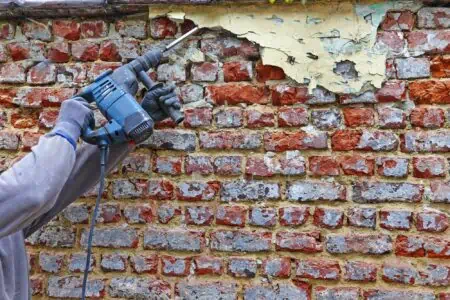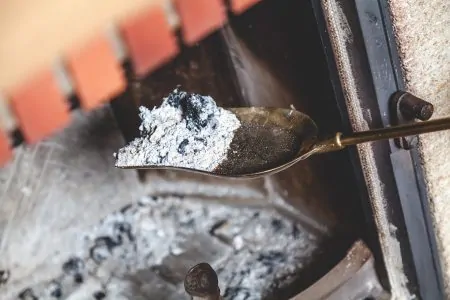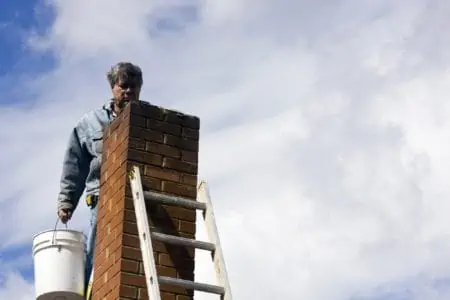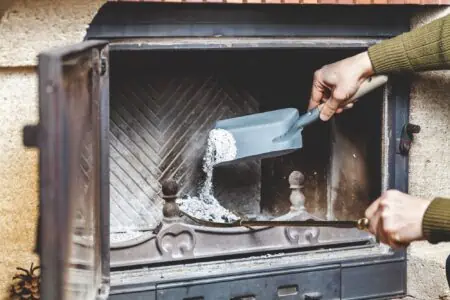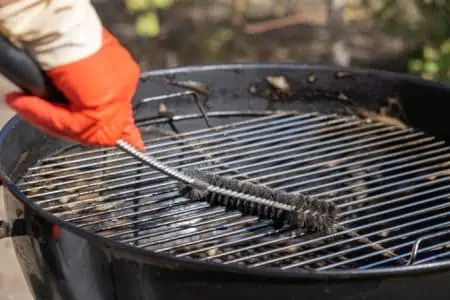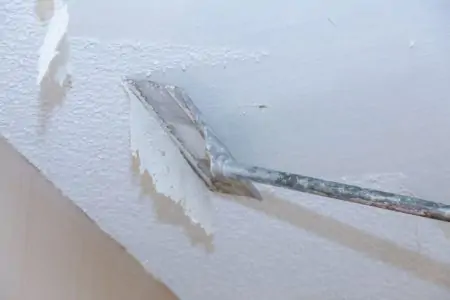Brick is a charming and durable material, beautiful for a home’s interior or exterior. But because it’s often used in high-traffic areas, it can stain easily.
We’ll show you how to remove stains from brick using easy-peasy methods. Whether you have mortar, hard water, rust, or black stains — we can help.
Bring your brick back to beauty using these expert-recommended methods!
Key Takeaways
- Brick stains can be caused by efflorescence, mortar, black mildew, rust, paint, graffiti, hard water, or algae.
- To remove black mildew stains, use a bleach solution, scrub with a nylon-bristled brush, and rinse with warm water.
- For efflorescence stains, brush away dry residue, rinse with water, and apply a cleaner like Eco-Etch Pro if necessary.
- Avoid using metal brushes, high pressure, muriatic acid, ammonia, drain cleaners, oven cleaners, or acetone when cleaning brick.
What Causes Brick To Stain?
Brick is a porous substance, meaning it absorbs stains easily. There are many common reasons that brick stains, all caused by individual factors. This includes:
- Efflorescence: This white stain is caused by a build-up of white salt. It usually appears in the joints and looks like chalk, but it can cover the brick, too.
- Mortar: When the mortar is applied poorly, it can dry onto the brick, leaving behind stains.
- Black mildew: Mold and mildew form on bricks when the brick is wet for a long time. This is even more likely if the brick is in a shady spot away from direct sunlight.
- Rust stains: Metal objects in contact with the brick can cause rust stains. For example, a pipe or chimney top can contribute.
- Paint and graffiti stains: If somebody has accidentally or purposely painted onto the brick, it can leave hard-to-remove stains.
- Hard water stains: When cleaning your brick with hard water, you can leave behind streaky stains.
- Algae stains: Algae grows when water drips down onto brick, especially in shaded areas. This is most common on brick walls located underneath roofs, near bodies of water, or after winter when the brick has been exposed to moisture for months.
How to Remove Stains From Brick
Removing stains from brick might be a challenge to begin with, but when you know what you’re working with — it’s easier. We’ll show you how to clean the common stains from above, removing them from red brick once and for all.
Mortar Stains
When mortar has been applied poorly, you can be left with stains. You can use a variety of cleaning solutions to remove this. We recommend a mortar dissolver if you want something without acid. But you can also use distilled white vinegar or muriatic acid.
- Dampen the surface: Spray plain water onto the surface.
- Apply the cleaner: Apply the cleaner to the brick using either a pump-up sprayer or dipping a stiff-bristled brush into the solution. Make sure to apply it evenly, and work from the top down.
- Wait: Leave the cleaning solution on the brick for a few minutes to soak it into the mortar. Read the product’s packaging instructions for the recommended waiting time.
- Scrub: Scrub the mortar well with a stiff fiber brush until you have removed the stains.
- Repeat: If necessary, repeat the above steps. It might take a few attempts to remove all stains.
- Rinse: Wash the brick once more to remove all cleaning solution residue.
- Air dry: Leave the bricks to air dry.
Efflorescence Stains
We recommend removing efflorescence stains on a day that is warm and dry. This will give you the best results.
- Brush: Use a stiff-bristled brush to work at the efflorescence. This can sweep away the dry residue. Make sure to wear a dust mask for your protection.
- Rinse: Rinse the brick with a garden hose or pressure washer to dissolve the stain. Start at the top and work your way down. If using a pressure washer, make sure to use a wide-angle tip to avoid damaging the brick.
- Apply cleaner: If necessary, you might need to apply a cleaner. For instance, Eco-Etch Pro works to remove efflorescence on brick. The best way to apply such a cleaner is with a pump sprayer.
- Scrub: Scrub the cleaner into the stain using a stiff-bristled brush.
- Wait: Depending on the product you use, leave it on the surface for the recommended time, usually around 10 minutes. During this time, make sure the cleaner doesn’t dry into the brick. If it starts to dry, reapply.
- Rinse: Rinse the area well to dissolve and remove the cleaning residue.
Top Tip
When you rinse the brick, it might bring salt to the surface as it dries. You might need to brush and rinse the brick a few times.
Black Mildew Stains
To remove black mildew or mold on brickwork, bleach is best.
This is super effective, but remember to wear protective gear and cover your plants and flowers. Also, let your family know about the project so kids, pets, and other members can stay away.
- Prep the cleaner: Mix one cup of bleach with a gallon of water. Increase the quantities as necessary.
- Rinse the brick: Use a garden hose or pressure washer to dampen the brick. This prevents it from absorbing too much bleach.
- Apply the bleach: Soak a sponge in the bleach and apply it to the brick, working on a small area at a time. You don’t want the bleach to dry, as this can discolor the brick.
- Scrub: Use a nylon-bristled brush to scrub the stained area. Work hard to remove the mildew stains.
- Rinse: Rinse the area with your garden hose. If you have access to warm water, that will help to break down the loosened mildew.
- Repeat: Repeat the above steps in the next area.
Rust Stains
Rust stains can be seriously annoying — and honestly, challenging to remove. But with this stain remover method, you have the best chance of removing the rust.
- Stay protected: We’ll be using some harsh chemicals for this, so stay protected. Wear protective eyewear, long-sleeved shirts, long pants, rubber gloves, and a face mask. Cover plants and flowers. Tell your family to stay away for the duration of the steps.
- Sand the area: Use fine sandpaper or steel wool to loosen the rust. Then use a bristled brush to sweep away loosened residue.
- Apply lemon juice: Starting with a non-toxic cleaner, let’s see how much rust this can remove. Make a paste with salt and lemon juice. Apply it to the stain for three hours. You might need to cover it with plastic wrap to keep it from falling off the wall. After three hours, remove the paste with a cloth.
- Apply a stronger cleaner: If the lemon juice didn’t remove everything, we need to move on to something stronger. Either use something that contains hydrochloric acid (which removes rust effectively) or a 1:1 water and bleach solution. Wipe the cleaner over the stains and wait 10 minutes before wiping it away with a wet towel.
- Rinse: Rinse the area well with a garden hose or pressure washer.
Expert Advice
If the above cleaners didn’t work, experts recommend trying oxalic acid. You can mix one pound of acid per gallon of water and apply it to the stain for five minutes. Always test oxalic acid in an inconspicuous spot to ensure it doesn’t further stain the brick.
Paint Stains
Whether you’ve accidentally spilled paint onto your brick or you’re removing old paint to reveal the original brick — we can help.
- Scrape: Start by using the flat edge of a trowel to scrape off as much paint as possible. Work at each area for about five minutes before moving on to the next step. Otherwise, you could spend all day scrubbing at a brick wall — boring!
- Sand off the paint: Using a specialized tool — such as the Wagner PaintEater — sand off as much paint as possible. This will make the following steps easier.
- Prepare paint stripper: You can buy a commercial paint stripper or mix your own solution of trisodium phosphate (TSP). This is a super powerful cleaner. Mix ⅛ cup of TSP per gallon of water. Since this is a potent cleaner, make sure to wear protective gear.
- Apply: Apply the cleaner by dipping in a long-handled stiff-bristled brush and scrubbing it onto the paint.
- Wait: Once you’ve applied an even coating to the area, leave it for 10 minutes.
- Scrub: Scrub the area again to remove the paint. Repeat steps four to six until all the paint has been removed.
- Rinse: Using warm water, if possible, rinse the brick well.
Graffiti Stains
To remove graffiti stains, you can try the above method for removing paint.
However, there are many effective graffiti and spray paint removers that we recommend trying first. For example, the Motsenbocker’s Lift-Off Paint Scuff and Graffiti Remover is excellent for brick.
- Test: Always test a new product in an inconspicuous area to ensure it doesn’t create new stains.
- Spray: Spray the cleaner onto the graffiti stain and wait for the recommended time.
- Scrub: Scrub the area with a stiff-bristled brush.
- Rinse: Rinse the area. For best results, use a low PSI pressure washer, such as one under 1000.
- Repeat: Repeat the above steps until all graffiti stains are gone.
Hard Water Stains
We’ll use a vinegar solution to clean away hard water stains. However, if you need something stronger, a commercial brick cleaner — like Saver Systems Brick & Mortar Cleaner — can do the trick.
- Apply vinegar: Apply undiluted vinegar to the brick using a pump sprayer or a stiff-bristled brush.
- Wait: Leave the vinegar on the brick for five minutes.
- Brush: Scrub the area with a stiff-bristled brush to work in the solution and remove stains.
- Rinse: Rinse the area with clean water. If you can get a filter on your hose, pressure washer, or water supply, this will help to prevent hard water stains.
Algae Stains
Algae stains can be pesky. While removing them is easy, they’ll come right back if you don’t stop them at the source. So if yours are caused by a leaky roof, fix those gutters to prevent the algae stains.
- Choose the right day: It’s best to remove algae stains on a sunny day. The dry, warm weather will help to dry the algae out, leaving you with no stains.
- Protect the area: Since we’ll use distilled white vinegar, protect your plants, flowers, and crops. Cover them with a tarp.
- Apply vinegar: Apply undiluted distilled white vinegar directly to the algae and stains. Cover it generously, leaving it on for a few hours as the algae dies away. Repeat if necessary.
- Scrape: Scrape off the loosened stains and discard them.
- Rinse: Rinse the area well.
What Not To Use To Clean Brick
The good news about cleaning bricks is that you can use various cleaning products. However, there are some things you should avoid:
- Metal items: Wire or metal brushes are a no-no on brick. The metal can leave behind a residue that causes rust.
- High pressure: Using a pressure washer is fine, but we recommend a wide nozzle and a maximum PSI of 1000. You should never pressure wash old or damaged bricks.
- Muriatic acid: You can use muriatic acid to remove mortar stains, but don’t use it for general brick cleaning. It will dissolve the mortar joints.
- Ammonia: Ammonia cleaners can damage your brick and sealant.
- Drain cleaners and oven cleaners: Cleaners made for specific tasks, like ovens and drains, should be avoided when cleaning bricks.
- Acetone: Some people like using acetone to remove paint from bricks, but our research found that it can damage and dull down your brick.
FAQs
Brick Stain Recap
Knowing how to get rid of stains from brick is crucial for keeping this material in mint condition. Whether your brick area is indoors or outdoors, you can use these tips to get rid of stains. This includes mortar, efflorescence, mildew, and more.
The top tip is to use the right approach for your specific stain. Using the vinegar approach works well on hard water stains, but it won’t do much for graffiti.
When in doubt, call a professional who can eliminate these stains without damaging your brickwork.
